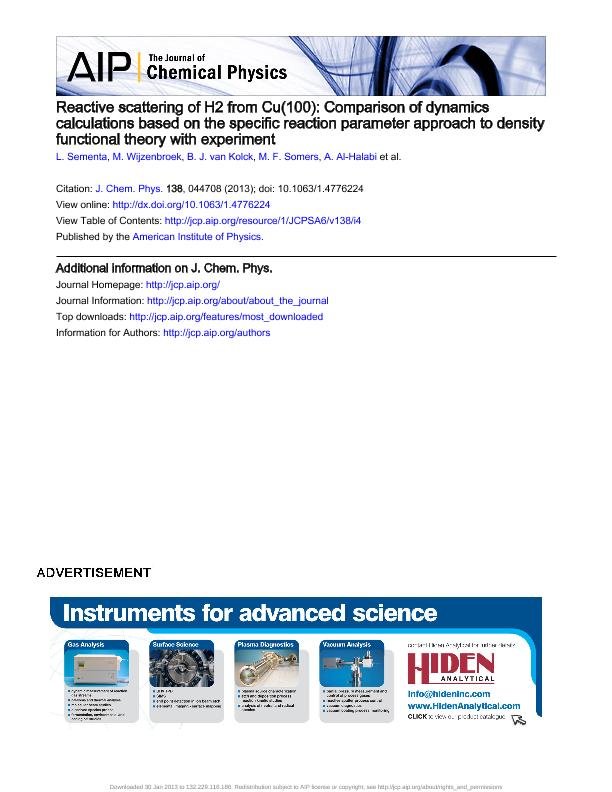Mostrar el registro sencillo del ítem
dc.contributor.author
Sementa, L.
dc.contributor.author
Wijzenbroek, M.
dc.contributor.author
Van Kolck, B. J.
dc.contributor.author
Somers, M. F.
dc.contributor.author
Al-Halabi, A.
dc.contributor.author
Busnengo, Heriberto Fabio

dc.contributor.author
Olsen, R. A.
dc.contributor.author
Kroes, G. J.
dc.contributor.author
Rutkowski, M.
dc.contributor.author
Thewes, C.
dc.contributor.author
Kleimeier, N. F.
dc.contributor.author
Zacharias, H.
dc.date.available
2016-06-01T12:42:05Z
dc.date.issued
2013-01-25
dc.identifier.citation
Sementa, L.; Wijzenbroek, M.; Van Kolck, B. J.; Somers, M. F.; Al-Halabi, A.; et al.; Reactive scattering of H2 from Cu(100): comparison of dynamics calculations based on the specific reaction parameter approach to density functional theory with experiment; American Institute of Physics; Journal of Chemical Physics; 138; 4; 25-1-2013; 44708-44727
dc.identifier.issn
0021-9606
dc.identifier.uri
http://hdl.handle.net/11336/5971
dc.description.abstract
We present new experimental and theoretical results for reactive scattering of dihydrogen from Cu(100). In the new experiments, the associative desorption of H2 is studied in a velocity resolved and final rovibrational state selected manner, using time-of-flight techniques in combination with resonance-enhanced multi-photon ionization laser detection. Average desorption energies and rota- tional quadrupole alignment parameters were obtained in this way for a number of (v = 0, 1) ro- tational states, v being the vibrational quantum number. Results of quantum dynamics calculations based on a potential energy surface computed with a specific reaction parameter (SRP) density func- tional, which was derived earlier for dihydrogen interacting with Cu(111), are compared with the results of the new experiments and with the results of previous molecular beam experiments on sticking of H2 and on rovibrationally elastic and inelastic scattering of H2 and D2 from Cu(100). The calculations use the Born-Oppenheimer and static surface approximations. With the functional derived semi-empirically for dihydrogen + Cu(111), a chemically accurate description is obtained of the molecular beam experiments on sticking of H2 on Cu(100), and a highly accurate descrip- tion is obtained of rovibrationally elastic and inelastic scattering of D2 from Cu(100) and of the orientational dependence of the reaction of (v = 1, j = 2 − 4) H2 on Cu(100). This suggests that a SRP density functional derived for H2 interacting with a specific low index face of a metal will yield accurate results for H2 reactively scattering from another low index face of the same metal, and that it may also yield accurate results for H2 interacting with a defected (e.g., stepped) surface of that same metal, in a system of catalytic interest. However, the description that was obtained of the average desorption energies, of rovibrationally elastic and inelastic scattering of H2 from Cu(100), and of the orientational dependence of reaction of (v = 0, j = 3 − 5, 8) H2 on Cu(100) compares less well with the available experiments. More research is needed to establish whether more accurate SRP-density functional theory dynamics results can be obtained for these observables if surface atom motion is added to the dynamical model. The experimentally and theoretically found dependence of the rotational quadrupole alignment parameter on the rotational quantum number provides evidence for rotational enhancement of reaction at low translational energies.
dc.format
application/pdf
dc.language.iso
eng
dc.publisher
American Institute of Physics

dc.rights
info:eu-repo/semantics/openAccess
dc.rights.uri
https://creativecommons.org/licenses/by-nc-sa/2.5/ar/
dc.subject
Surfaces
dc.subject
Hydrogen
dc.subject
Dft
dc.subject.classification
Física Atómica, Molecular y Química

dc.subject.classification
Ciencias Físicas

dc.subject.classification
CIENCIAS NATURALES Y EXACTAS

dc.title
Reactive scattering of H2 from Cu(100): comparison of dynamics calculations based on the specific reaction parameter approach to density functional theory with experiment
dc.type
info:eu-repo/semantics/article
dc.type
info:ar-repo/semantics/artículo
dc.type
info:eu-repo/semantics/publishedVersion
dc.date.updated
2016-05-27T20:14:07Z
dc.journal.volume
138
dc.journal.number
4
dc.journal.pagination
44708-44727
dc.journal.pais
Estados Unidos

dc.journal.ciudad
New York
dc.description.fil
Fil: Sementa, L.. Leiden University; Países Bajos. Istituto per i Processi Chimico-Fisici of the Consiglio Nazionale delle Ricerche; Italia
dc.description.fil
Fil: Wijzenbroek, M.. Leiden University; Países Bajos
dc.description.fil
Fil: Van Kolck, B. J.. Leiden University; Países Bajos
dc.description.fil
Fil: Somers, M. F.. Leiden University; Países Bajos
dc.description.fil
Fil: Al-Halabi, A.. Leiden University; Países Bajos
dc.description.fil
Fil: Busnengo, Heriberto Fabio. Consejo Nacional de Investigaciones Científicas y Técnicas. Centro Científico Tecnológico Rosario. Instituto de Física de Rosario (i); Argentina
dc.description.fil
Fil: Olsen, R. A.. Leiden University; Países Bajos. SINTEF Materials and Chemistry; Noruega
dc.description.fil
Fil: Kroes, G. J.. Leiden University; Países Bajos
dc.description.fil
Fil: Rutkowski, M.. Westfalische Wilhelms Universitat; Alemania
dc.description.fil
Fil: Thewes, C.. Westfalische Wilhelms Universitat; Alemania
dc.description.fil
Fil: Kleimeier, N. F.. Westfalische Wilhelms Universitat; Alemania
dc.description.fil
Fil: Zacharias, H.. Westfalische Wilhelms Universitat; Alemania
dc.journal.title
Journal of Chemical Physics

dc.relation.alternativeid
info:eu-repo/semantics/altIdentifier/doi/http://dx.doi.org/10.1063/1.4776224
dc.relation.alternativeid
info:eu-repo/semantics/altIdentifier/doi/10.1063/1.4776224
dc.relation.alternativeid
info:eu-repo/semantics/altIdentifier/url/http://scitation.aip.org/content/aip/journal/jcp/138/4/10.1063/1.4776224
Archivos asociados
